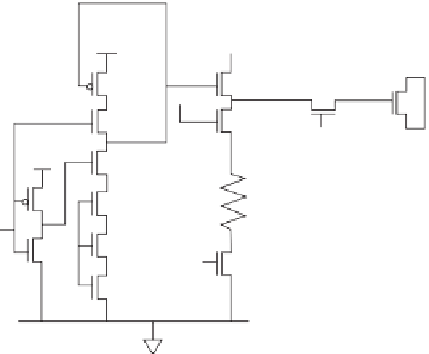Information Technology Reference
In-Depth Information
17.4. A CARBON NANOTUBE SYNAPSE
This section presents a novel carbon nanotube synaptic circuit, and we provide
some SPICE simulation results that demonstrate the range of synaptic behaviors
possible.
The carbon nanotube synaptic circuit is shown in Figure 17.2. Action
potentials (see Fig. 17.3) arrive from the presynaptic neuron and terminate in
our synaptic circuit. The simple piecewise action potential used here is an
approximation of a biological action potential [76]. A single postsynaptic terminal
is shown in this figure. An incoming action potential will cause the potential in the
synaptic cleft to rise via the pull-up network. The PFET limits the peak amplitude
of the synaptic cleft potential by turning off before the synaptic cleft potential
rises to Vdd. The synaptic cleft potential in the electronic neuron (also shown
in Fig. 17.3) models the biological release of neurotransmitters stored in the
presynaptic neuron into the cleft, where they bind to receptor proteins on the
recipient (postsynaptic) neuron, causing the potential across the postsynaptic
neural membrane to change. Once the neurotransmitters are released from the
presynaptic terminal and bound in the postsynaptic terminal, they will be cleared
from the synaptic cleft by reuptake mechanisms. The presence of bound neuro-
transmitters is represented electronically by a potential increase in the synaptic
cleft. Vesicles depleted of neurotransmitters will be replenished in the presynaptic
terminal. Reuptake is modeled via the pull-down network attached to the synaptic
cleft.
2
The reuptake control voltage, R, is an analog potential, which allows the
Vdd
E channel
Dendritic
trunk
Vdd
Synaptic
interior
Vdd
Load
Synaptic
cleft
Rpulldown
Action
potential
R
Pump
Figure
17.2.
The carbon nanotube synaptic circuit.
2
Since the SPICE model used in this study is geared toward short gate length transistors with near-
ballistic transport, we use three transistors in series to model the resistance that represents the reuptake
delay. The quantum contact resistances of the three transistors are added in series.







Search WWH ::

Custom Search